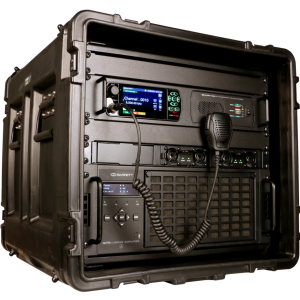
Ship-to-shore and ship-to-ship radio communications systems have been around for a long time, but over the last couple of decades or so, they lost some of their lustre when digital communication systems began to gain prominence due to ease of use and cost benefits.
And why not?
Digital communications, using inexpensive mobile handsets which can connect people via satellites that cover the whole globe, are ubiquitous. In a relatively short time, they took over as the preferred method of voice and data transmissions for almost all walks of life.
But there is a caveat. Although communication satellites and other spacecraft are protected from the rigours of space such as radiation and debris, they are susceptible to attacks from the ground such as “jamming” (which disables satellite-ground communication) and “spoofing” (sending unauthorised signals to a satellite).
These methods can be used to interfere with a satellite’s regular operations, to hijack it, or even to send false commands that could cause the satellite to fall out of orbit and be destroyed.
And the above scenario is why good old radio waves are regaining ground as a safe and secure communications media. Here we examine what systems are involved to create coastal and maritime communications systems with the latest radio technology applications to ensure 24/7 availability, for both Line-of-Sight (LOS) and Beyond Line-of-Sight (BLOS) communications.
The Global Maritime Distress and Safety System (GMDSS)
The installation of radio communication equipment on board ships has boosted maritime safety. However, at first, neither the usage of radio communication on a vessel nor the process for alerting search and rescue organisations to a distress signal was particularly well-organised.
Making ship-to-ship notifications on the designated distress frequencies was the key component of it. After the transmission of the distress calls, there was frequently no reception or just no response. GMDSS was therefore developed to address this issue, and consists of the following interconnected systems:
- Inmarsat – a global mobile satellite communication system providing two-way data and messaging
- NAVTEX – an international automated service for delivery of navigational and meteorological warnings, forecasts and urgent maritime safety information to ships
- EPIRB – emergency position indicator radio beacons are automated identification and locator device for Search and Rescue operations
- SART – search and rescue transponders automatically lead Search and Rescue units to distressed vessels
- DSC – digital selective calling is a standard for sending pre-defined digital messages from ship to ship, ship-to-shore, and shore-to-ship
Barrett HF SSB 1.5 – 30 MHz Transceiver platforms
The Barrett HF turn-key systems can be easily customised to satisfy a variety of operating requirements and have been field tested in more than 150 countries. The platforms support all current Selective Call formats, an optional MIL-STD 188-141B Automatic Link Establishment (ALE), and a modern, user-friendly frequency hopping option. It can also be configured to handle GMDSS shore-to-ship systems.
For emergencies, security concerns, or tactical applications, these devices are perfect for any radio communications. The transceivers can be configured for usage as base stations, manpack portables, land mobiles, and maritime variants. Barrett provides systems ranging from 30W to 1kW PEP (Peak envelope power) that are appropriate for shore stations, small boats, and big seagoing vessels.
Barrett digital voice and high-speed data solutions have a proven track record of delivering dependable, line-of-sight and beyond-line-of-sight voice and data communications in maritime applications beyond the range where typical line-of-sight VHF and UHF systems fail; where alternate satellite communications (SATCOM) or terrestrial solutions are unavailable.
When configured with other Barrett modules, the system can support secure email, fax, and telephone connections, and has been installed in naval, police, and border security, cargo, and pleasure vessels globally.
Chile coastal radio installation
DIRECTEMAR, Chile’s Directorate General of the Maritime Territory and Merchant Marine, has the mission of protecting the safety of navigation in its 12 miles of territorial waters and the 188 miles of its exclusive economic zone. It also has the role of preserving the aquatic environment and marine natural resources around its coastal waters.
To help support this, it requires a maritime telecommunications system that allows it to cover the entire national, continental and internal territory, and the transmitters powering the systems are high-power Barrett HF-2075 radio equipment (1KW), which are installed at the Quintero plant with high power antennas. The receiver plant is located between Concon and Quintero on its South Pacific coast.
There is analogue communication, and the equipment is integrated into DIRECTEMAR’s legacy systems and operated remotely from Playa Ancha in Valparaiso, northwest of the capital, Santiago.
The Barrett 4075 High Power HF Transmitter System
One of the company’s latest systems, together with the 4050 SDR Transceiver, is an outstanding liquid-cooled amplifier that will function continuously at high power for extended data transmission and at ideal temperatures, resulting in higher reliability.

The radio is designed to serve as a static base station in locations where HF radio may be the only functional communications network. It offers a lightweight, high-power HF transceiver that is perfect for usage in harsh conditions.
The 4075 amplifier’s cutting-edge liquid-cooled solid-state architecture is thought to be the first of its kind. The cooling system, which makes use of a water-propylene-glycol solution, enables the transmitter to operate constantly at optimal temperatures while lowering the need for forced air cooling. This design is more power-efficient, reliable, has a longer service life, and creates a considerably quieter working environment.
It is made to work with Barrett’s 4050 Transceiver/Exciter, without additional tuning or adjustment once connected. The transceiver/exciter has complete control over ultimate output power thanks to a versatile I/O interface and analogue ALC feedback. The 4075 is shielded from input and output overload by intelligent electronic controls, which also offer a sophisticated early warning system and a diagnostic interface for system monitoring and event logging.
The exciter may be easily controlled remotely using PC, tablet, and smartphone applications thanks to in-built IP connectivity. The ED-137c protocol and customisable auxiliary ports enable enhanced system control.
The 4075 system can be field reprogrammed through USB, enabling system software updates by the end user. Improved flexibility for display customization and event tracking is provided by an on-board micro-SD card.
Further details on emergency radio communication:
Please visit www.barrettcomms.com



